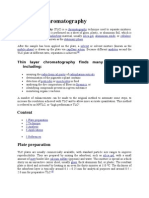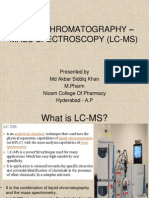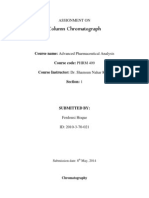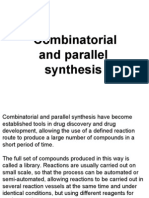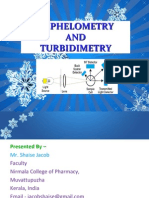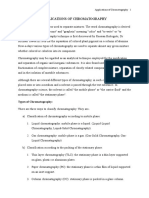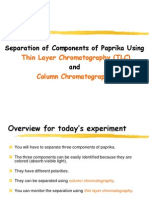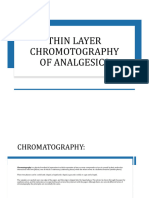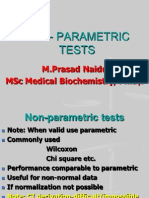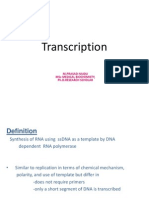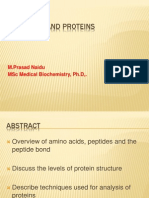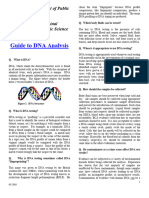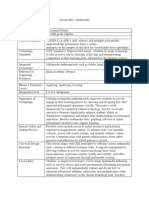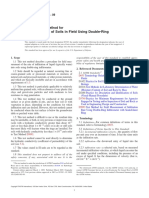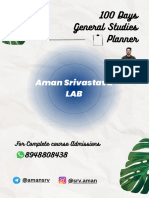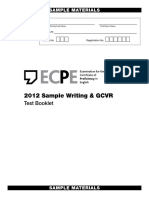Thin Layer Chromatography
Thin Layer Chromatography
Uploaded by
Dr. M. Prasad NaiduCopyright:
Available Formats
Thin Layer Chromatography
Thin Layer Chromatography
Uploaded by
Dr. M. Prasad NaiduOriginal Description:
Copyright
Available Formats
Share this document
Did you find this document useful?
Is this content inappropriate?
Copyright:
Available Formats
Thin Layer Chromatography
Thin Layer Chromatography
Uploaded by
Dr. M. Prasad NaiduCopyright:
Available Formats
THIN LAYER CHROMATOGRAPHY (TLC)
AND
COLUMN CHROMATOGRAPHY
M.PRASAD NAIDU
Msc Medical
Biochemistry,
Ph.D Research scholar.
You will have to separate three components of paprika.
The three components can be easily identified because they are
colored (absorb visible light).
They have different polarities.
They can be separated using column chromatography.
You can monitor the separation using thin layer chromatography.
What is chromatography.
Chromatography
Very useful technique in organic chemistry
based on differential adsorption.
Used to separate components in a mixture
(solid or liquid).
It depends on the polarity of the ingredients
involved --- intermolecular forces!!
Thin layer chromatography (TLC) is used to
analyze components and purity of a mixture.
Thin layer chromatography (TLC) is also used
to monitor the progress of a reaction.
Chromatography
What do we need to perform a
chromatographic separation?
Adsorbent: Silica gel (silicon dioxide), also
called stationary phase.
Eluent: solvent used to move your compound
trough the silica gel, also called the mobile
phase.
Your compound mixture to be separated.
Patience and chemical intuition.
Chromatography
More polar molecules stick to the adsorbent longer.
Less polar molecule separate more easily from the
adsorbent.
When this happens, separation occurs.
SiOH
SiOH
SiOH
SiOH
SiOH
SiOH
SiOH
SiOH
SiOH
SiOH
SiOH
SiOH
Stationary phase To be separated
O
Eluent (mobile phase)
Chromatography
More polar solvent move the molecules more efficiently
Less polar move the molecules less efficiently
Separation occurs
Most polar
Least polar
Alkanes
Toluene
Diethyl ether
Chloroform
Acetone
Ethyl acetate
Ethanol
Methanol (CH
3
OH)
Column Chromatography
Load the silica gel plus eluent into the
columnthis is called column packing
Column Chromatography
Using a Pasteur pipette, load your compound that was dissolved
in a minimum of solvent onto the silica.
Your test solution will then add the eluent.
Do not let your column run dry!!
Thin Layer Chromatography
Typical TLC chamber
We will use beaker with watch glass or aluminum foil
Thin Layer Chromatography
Spotting TLC plate
Use different capillary for each
solution.
make solution of approx. 1-2 mg
of sample in 1 ml of solvent.
Spot 2-3 times
Try to make small spots
Insert filter paper to saturate atmosphere with solvent
Keep the lid on!!
Thin Layer Chromatography
preparation of chamber
Mark a line about 1 cm
from the bottom with pencil
It is important to use pencil
Place TLC plate in chamber
Let things develop!
Dont let the solvent front run off
The top of the plate!!
Pull it out and mark the solvent front
before it evaporates
Mark spots with pencil!
Good, bad and ugly
First TLC shows
overloading" due
to too much sample.
Second shows good
separation.
Third shows almost
not enough compound,
but OK
You might also like
- Lecture 5 - Ultraviolet and Visible (UV-Vis) SpectrosDocument40 pagesLecture 5 - Ultraviolet and Visible (UV-Vis) SpectrosBelay HaileNo ratings yet
- Applications of ChromatographyDocument11 pagesApplications of ChromatographyRadowan Ahmad92% (24)
- Visible and Ultraviolet SpectrosDocument55 pagesVisible and Ultraviolet SpectrosMarcos ShepardNo ratings yet
- Principles of Colorimetric MeasurementsDocument8 pagesPrinciples of Colorimetric MeasurementsDipmalya Basak100% (1)
- Uv Visible SpectrosDocument50 pagesUv Visible SpectrosVacker Guzel67% (3)
- A Laboratory Manual of Physical PharmaceuticsFrom EverandA Laboratory Manual of Physical PharmaceuticsRating: 2.5 out of 5 stars2.5/5 (2)
- Sartorius Stedim Biotech 2020 Investor PresentationDocument61 pagesSartorius Stedim Biotech 2020 Investor PresentationRLNo ratings yet
- Advanced End of Course Test B: ListeningDocument4 pagesAdvanced End of Course Test B: ListeningGERESNo ratings yet
- Column ChromatographyDocument31 pagesColumn ChromatographySuman GhoshNo ratings yet
- Thin Layer ChromatographyDocument4 pagesThin Layer Chromatographynaveenbimal2005No ratings yet
- 5.column and Thin Layer ChromatographyDocument3 pages5.column and Thin Layer ChromatographyroseannequyoNo ratings yet
- Thin Layer ChromatographyDocument2 pagesThin Layer ChromatographyOdessa Vidallon100% (3)
- Unit 7 Flame PhotometryDocument32 pagesUnit 7 Flame PhotometryRia Agnez100% (8)
- Chapter 5 Principle and Application of UV and Visible SpectrosDocument24 pagesChapter 5 Principle and Application of UV and Visible SpectrosEsuendalew DebebeNo ratings yet
- Introduction To UV-Vis SpectrosDocument5 pagesIntroduction To UV-Vis SpectrosShahul0% (1)
- Paper ChromatographyDocument32 pagesPaper ChromatographyAhmed Halawa100% (1)
- Adsorptiona Partition ChromatographyDocument20 pagesAdsorptiona Partition ChromatographySATYA SRIVASTAVANo ratings yet
- FlameDocument28 pagesFlameAnonymous 9G6FV4xn100% (1)
- Column ChromatographyDocument17 pagesColumn ChromatographyDommaraju varunNo ratings yet
- Thin Layer Chromatography TheoryDocument4 pagesThin Layer Chromatography TheoryJonas AlvimNo ratings yet
- Report Thin Layer Chromatography On Lipid DetectionDocument14 pagesReport Thin Layer Chromatography On Lipid Detectionatiqah0% (1)
- LC MsDocument24 pagesLC MsVshn VardhnNo ratings yet
- Column and Thin Layer ChromatographyDocument3 pagesColumn and Thin Layer ChromatographyAileen Delos SantosNo ratings yet
- Lecture 1 - Introduction To Secondary MetabolitesDocument36 pagesLecture 1 - Introduction To Secondary MetabolitesAlec LiuNo ratings yet
- Column Chromatography - Principle, Procedure, ApplicationsDocument1 pageColumn Chromatography - Principle, Procedure, ApplicationsSahiba ChadhaNo ratings yet
- Fluorimetry & PhosphorimetryDocument26 pagesFluorimetry & PhosphorimetryAnonymous bQJydI100% (1)
- PHR-224L (Pharmaceutical Analysis Lab) - IDocument22 pagesPHR-224L (Pharmaceutical Analysis Lab) - ISanjida Khandoker 1911009049No ratings yet
- Physico-Chemical Properties of DrugsDocument33 pagesPhysico-Chemical Properties of DrugsPavol JežkoNo ratings yet
- Introduction To Chromatographic SeparationsDocument49 pagesIntroduction To Chromatographic SeparationsNur Farzana bt Muhamad Ismail100% (1)
- An Introduction To Mass Spectrometry PDFDocument21 pagesAn Introduction To Mass Spectrometry PDFprakas.rao39695100% (1)
- ASSIGNMENT On Column ChromatographyDocument4 pagesASSIGNMENT On Column ChromatographyRinta Moon50% (2)
- Combinatorial and Parallel SynthesisDocument55 pagesCombinatorial and Parallel SynthesisMahfuz AlamNo ratings yet
- IR SpectrosDocument119 pagesIR SpectrosRojan Pradhan100% (1)
- FST-601 - F00 - BASIC PRINCIPLES OF CHROMATOGRAPHY-7th WeekDocument32 pagesFST-601 - F00 - BASIC PRINCIPLES OF CHROMATOGRAPHY-7th WeekKashif MehmoodNo ratings yet
- Nephlometry and TurbidimetryDocument25 pagesNephlometry and TurbidimetryShaise JacobNo ratings yet
- Flame PhotometryDocument18 pagesFlame Photometrysaramanae100% (1)
- T.Y.B.Sc. 1.3 Amperometric TitrationsPPTDocument19 pagesT.Y.B.Sc. 1.3 Amperometric TitrationsPPTAhmed Al balawiNo ratings yet
- Column Chromatography 2Document24 pagesColumn Chromatography 2syed shayanNo ratings yet
- Uv Visible SpectrosDocument6 pagesUv Visible Spectrospankajbhattb_pharmaNo ratings yet
- Normal and Reverse Phase ChromatographyDocument22 pagesNormal and Reverse Phase ChromatographyHemanth Achamveedu100% (10)
- Chemistry of FlavonoidsDocument15 pagesChemistry of FlavonoidsSathish SizzyNo ratings yet
- Thin Layer ChromatographyDocument8 pagesThin Layer ChromatographyIsabel RinconNo ratings yet
- Ultraviolet-Visible Spectroscopy (Uv-Vis) - FinalDocument15 pagesUltraviolet-Visible Spectroscopy (Uv-Vis) - FinalSwati V NairNo ratings yet
- HPLCDocument2 pagesHPLCHarish KalaiyarvanNo ratings yet
- Applications of ChromatographyDocument11 pagesApplications of ChromatographyKallool91100% (1)
- ChromatographyDocument22 pagesChromatographyNagendran100% (1)
- Molecular Fluorescence SpectrosDocument9 pagesMolecular Fluorescence SpectrosInga Budadoy NaudadongNo ratings yet
- Mass Spectroscopy: - : Presented By:-Amruta S. Sambarekar 1 Year M.Pharm Dept. of Pharmaceutics M M C P, BelgaumDocument56 pagesMass Spectroscopy: - : Presented By:-Amruta S. Sambarekar 1 Year M.Pharm Dept. of Pharmaceutics M M C P, BelgaumSudeep_Kolhar_5702No ratings yet
- Drug MetabolismDocument78 pagesDrug Metabolismjuz gonzagaNo ratings yet
- ColorimetryDocument21 pagesColorimetryM.PRASAD NAIDUNo ratings yet
- Uv Visible SpectrosDocument28 pagesUv Visible Spectrosjoshishravan3003100% (1)
- Principles of IR SpectrosDocument6 pagesPrinciples of IR SpectrosSHEHA NUR AZZAHRA IBRAHIM -No ratings yet
- UV-Vis Spectroscopy: Chm622-Advance Organic SpectrosDocument50 pagesUV-Vis Spectroscopy: Chm622-Advance Organic Spectrossharifah sakinah syed soffianNo ratings yet
- High Performance Liquid ChromatographyDocument22 pagesHigh Performance Liquid Chromatographygenjihimora2102No ratings yet
- 2 Medicinal Chemistry 2-Drug Metabolism-Smsrt GanjilDocument39 pages2 Medicinal Chemistry 2-Drug Metabolism-Smsrt GanjilPark arimaNo ratings yet
- Electrophoresis: Dr.T.Bheema LingaiahDocument65 pagesElectrophoresis: Dr.T.Bheema LingaiahAmir100% (2)
- Separation of Components of Paprika UsingDocument16 pagesSeparation of Components of Paprika UsingGyleen ElegioNo ratings yet
- TLC PresentationDocument21 pagesTLC PresentationFazal AliNo ratings yet
- Water Soluble VitaminsDocument55 pagesWater Soluble VitaminsDr. M. Prasad Naidu100% (1)
- Thyroid HormonesDocument63 pagesThyroid HormonesDr. M. Prasad NaiduNo ratings yet
- Vitamin-A: M.Prasad Naidu MSC Medical Biochemistry, PH.DDocument42 pagesVitamin-A: M.Prasad Naidu MSC Medical Biochemistry, PH.DDr. M. Prasad NaiduNo ratings yet
- Non-Parametric Tests: M.Prasad Naidu MSC Medical Biochemistry, PH.DDocument15 pagesNon-Parametric Tests: M.Prasad Naidu MSC Medical Biochemistry, PH.DDr. M. Prasad NaiduNo ratings yet
- Translation: M.Prasad Naidu MSC Medical Biochemistry, PH.DDocument33 pagesTranslation: M.Prasad Naidu MSC Medical Biochemistry, PH.DDr. M. Prasad NaiduNo ratings yet
- TGF-β Signalling From CellDocument14 pagesTGF-β Signalling From CellDr. M. Prasad NaiduNo ratings yet
- Signal TransductionDocument77 pagesSignal TransductionM.PRASAD NAIDUNo ratings yet
- STUDENT T-TestDocument20 pagesSTUDENT T-TestDr. M. Prasad NaiduNo ratings yet
- M.Prasad Naidu MSC Medical Biochemistry, PH.DDocument23 pagesM.Prasad Naidu MSC Medical Biochemistry, PH.DDr. M. Prasad NaiduNo ratings yet
- Transcription: M.Prasad Naidu MSC Medical Biochemisty, Ph.D.Research ScholarDocument33 pagesTranscription: M.Prasad Naidu MSC Medical Biochemisty, Ph.D.Research ScholarDr. M. Prasad NaiduNo ratings yet
- M.Prasad Naidu MSC Medical Biochemistry, PH.DDocument17 pagesM.Prasad Naidu MSC Medical Biochemistry, PH.DDr. M. Prasad NaiduNo ratings yet
- Urea CycleDocument8 pagesUrea CycleDr. M. Prasad Naidu100% (1)
- Sequence DatabaseDocument36 pagesSequence DatabaseDr. M. Prasad NaiduNo ratings yet
- Sex HormonesDocument10 pagesSex HormonesM.PRASAD NAIDUNo ratings yet
- Serum Ferritin and Diabetes Mellitus Type LLDocument21 pagesSerum Ferritin and Diabetes Mellitus Type LLM.PRASAD NAIDUNo ratings yet
- Rna Processing: M.Prasad Naidu MSC Medical Biochemistry, PH.DDocument33 pagesRna Processing: M.Prasad Naidu MSC Medical Biochemistry, PH.DDr. M. Prasad NaiduNo ratings yet
- Serum Protein Electrophoresis & Their Clinical ImportanceDocument44 pagesSerum Protein Electrophoresis & Their Clinical ImportanceDr. M. Prasad NaiduNo ratings yet
- Peptides and Proteins: M.Prasad Naidu MSC Medical Biochemistry, PH.DDocument30 pagesPeptides and Proteins: M.Prasad Naidu MSC Medical Biochemistry, PH.DDr. M. Prasad NaiduNo ratings yet
- Protein Synthesis: M.Prasad Naidu MSC Medical Biochemistry, PH.DDocument12 pagesProtein Synthesis: M.Prasad Naidu MSC Medical Biochemistry, PH.DDr. M. Prasad NaiduNo ratings yet
- Renal CalculiDocument49 pagesRenal CalculiDr. M. Prasad NaiduNo ratings yet
- Recombinant DNA TechnologyDocument34 pagesRecombinant DNA TechnologyDr. M. Prasad NaiduNo ratings yet
- Check Lists For Pre-Commissioning, Site Tests and EnergizingDocument2 pagesCheck Lists For Pre-Commissioning, Site Tests and EnergizingNitin KumarNo ratings yet
- Nigel Slack, Mike Lewis - Operations Strategy-Pearson (2018) (1) - 366-392Document27 pagesNigel Slack, Mike Lewis - Operations Strategy-Pearson (2018) (1) - 366-392Hello IbnuNo ratings yet
- DNAbroc03 0Document3 pagesDNAbroc03 0brandonzhen02No ratings yet
- The Theories and Approaches in Teaching MathematicsDocument50 pagesThe Theories and Approaches in Teaching MathematicsElla MarieNo ratings yet
- Poem 1 My Mother at Sixty SixDocument10 pagesPoem 1 My Mother at Sixty Sixletsrockitbby69No ratings yet
- Servey On DSMCDocument40 pagesServey On DSMCshakti_0001No ratings yet
- Case StudyDocument6 pagesCase StudyJESSON VILLA100% (1)
- Inbreathing Outbreathing of TanksDocument30 pagesInbreathing Outbreathing of Tanksomesh2008No ratings yet
- 5 Pythagoras - QUESTIONS PDFDocument4 pages5 Pythagoras - QUESTIONS PDFHenri LhomondNo ratings yet
- Lesson Idea MultimediaDocument2 pagesLesson Idea Multimediaapi-688129166No ratings yet
- Midterm 2023Document8 pagesMidterm 2023Desy PastinaNo ratings yet
- 66f77e4f8c3b3ch-11 Mixture and Separation 2024Document2 pages66f77e4f8c3b3ch-11 Mixture and Separation 2024annafialnashwan956No ratings yet
- HSSE-D-002 - HSSE Management System PDFDocument10 pagesHSSE-D-002 - HSSE Management System PDFAHMED AMIRANo ratings yet
- D3385-09 Standard Test Method For Infiltration Rate of Soils in Field Using Double-Ring InfiltrometerDocument7 pagesD3385-09 Standard Test Method For Infiltration Rate of Soils in Field Using Double-Ring InfiltrometerFaten Abou ShakraNo ratings yet
- Changes in ACI 318 Code Provisions For Earthquake Resistant StructuresDocument5 pagesChanges in ACI 318 Code Provisions For Earthquake Resistant StructuresTrầmLãngNo ratings yet
- Great Mathematicians in IndiaDocument18 pagesGreat Mathematicians in IndiaanantNo ratings yet
- Arxiv CanChatGPTAssessHumanPersonalitiesDocument19 pagesArxiv CanChatGPTAssessHumanPersonalitiesSam SoranNo ratings yet
- An Alternative To Additional SO3 Injection For Fly Ash ConditioningDocument7 pagesAn Alternative To Additional SO3 Injection For Fly Ash ConditioningmsoyoralNo ratings yet
- EDUC201 AssignmentDocument3 pagesEDUC201 AssignmentSharicka Anne Veronica TamborNo ratings yet
- 100 Days GKDocument13 pages100 Days GKhsjajnnbbNo ratings yet
- Soal PTS B Inggris Kelas 6 GanjilDocument8 pagesSoal PTS B Inggris Kelas 6 Ganjilsuin indartiNo ratings yet
- 2012 Sample Writing & GCVR: Test BookletDocument20 pages2012 Sample Writing & GCVR: Test BookletLidia Salvarrey PaivaNo ratings yet
- The MTMM Matrix NotesDocument7 pagesThe MTMM Matrix NotesFaraz Ahmed FarooqiNo ratings yet
- đềDocument4 pagesđềstu735701019No ratings yet
- Equity BriefingDocument19 pagesEquity Briefingsiraj.nvdsolarNo ratings yet
- Write You Answers On The Space Before Each NumberDocument2 pagesWrite You Answers On The Space Before Each NumberJESSA SUMAYANG0% (1)
- Sundaram Clayton'sDocument5 pagesSundaram Clayton'sRaymart GonzagaNo ratings yet










